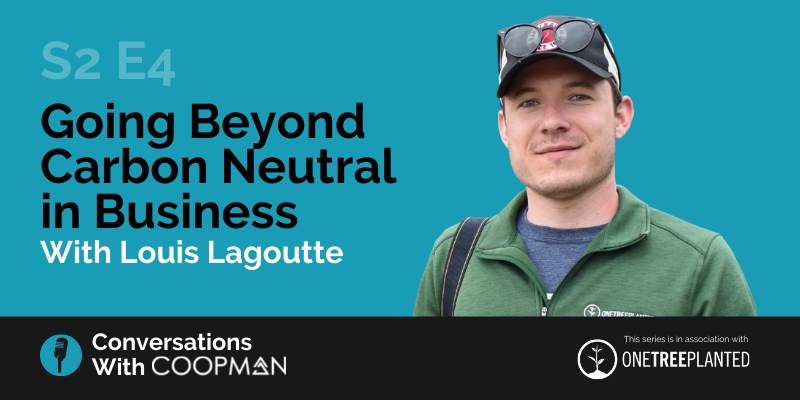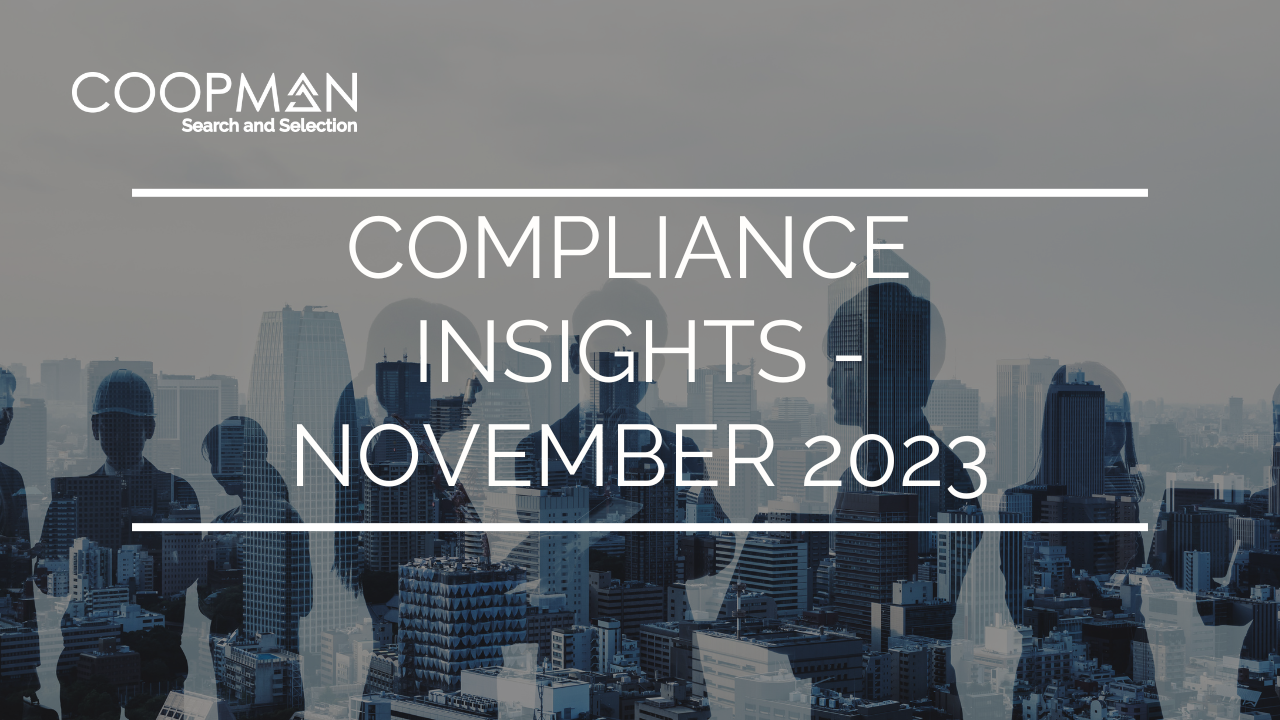Series 2 of Conversations With Coopman, Making Sustainability Your Business focuses on how businesses across financial services are embedding sustainability into their operations, as well as creating innovative solutions to tackle climate change and to have a positive impact on the environment. The series is in association with global non-profit reforestation organisation, One Tree Planted and for our fourth episode, Louis Lagoutte, who works on their strategic partnerships team joins co-hosts Andrew Murphy and Mark Fallon to discuss the benefits of global reforestation.
With a passion for rewilding and ecosystem restoration, Louis believes restoring natural systems can address many of our most pressing issues. Louis has been a core member of the strategic partnership team at One Tree Planted for over three years, where he works with companies of all sizes from the private sector to enable impact and scale up the company’s critical work to fulfil its mission to restore the planet’s forests.
In this episode, Louis talks about how One Tree Planted started and what they do, the trends he is seeing in sustainability and the challenges at ground level, as well as sharing his thoughts on COP26.
Some of the key discussion points from the conversation with Louis as well as the podcast recording and video are included below. To receive the latest podcast episodes straight to your inbox, sign-up to our podcast mailing list.
WHAT DOES ONE TREE PLANTED DO?
One Tree Planted supports projects in a range of different countries with the aim of restoring ecosystems, capturing carbon, creating space for wildlife, creating economic opportunities and so much more.
They work with local and international companies of all sizes across array of different industries to fund these projects, as well as partnering with organisations on the ground who manage the day-to-day running of them.
HOW DID ONE TREE PLANTED BEGIN?
Matt Hill is the founder of One Tree Planted, which started in 2014. He saw that many businesses were struggling to find simple and easy ways to get involved in sustainability and to have an impact in this area. As a result, Matt created the organisation’s model which is to plant one tree for every $1 donation.
Since the journey began, the organisation has grown substantially. In the first couple of years, they planted a few hundred thousand trees however, in 2022 the aim is 25 million and they hope to double this figure in 2023.
The organisation puts a huge emphasis on collaboration, particularly with its project partners such as the Jane Goodall Institute in Uganda which is doing amazing work in restoring the chimpanzee habitat and working with local land owners to restore their forests and also create job opportunities for the community. Other organisations include the United States Forest Service and Cal Fire in California who restore forests affected by fires, as well as an indigenous women’s group in Ecuador who do a lot of community led restoration and many more.
One Tree Planted has been fortunate to not be greatly impacted by the pandemic. A lot of their work was delegated to different countries who already had the infrastructure and resources on the ground to run their projects. In addition to this, as business slowed down for many companies due to various Covid-19 restrictions, it afforded them the time to reassess and reevaluate which has resulted in a lot of them realising they want to do more for sustainability.
WHAT IS THE IMPACT OF CLIMATE CHANGE AT GROUND LEVEL ON REFORESTATION?
Climate change is an overarching symptom of the problematic relationship we have with the natural world, but it is also not the only one. The majority of forest loss at the moment is not due to climate change, it is due to a change in land use, to people chopping down forests for the likes of soy or palm, so we need to look at how climate change is impacting it, but also how agriculture is impacting it, how pollution is impacting it and so on.
What is interesting at ground level that is having great impact is the trees being planted. When restoring forests, many of the projects use a principle called FLR (forest landscape restoration). It results in a mix of species of trees being planted as the more diverse the ecosystem, the more resilient it is, so if one tree gets sick, there are many others to take its place. There’s also a greater diversity of wildlife in these areas.
These species mixes are being planted for 40- or 50-years’ time and are of great benefit to restoration as projects are being designed around predicted climate change. For example, trees are going higher in altitude so they can withstand colder months, or are more drought resistant particularly on the West Coast of the USA.
WHAT TRENDS ARE HAPPENING IN THE AREA OF SUSTAINABILITY?
The sustainability discourse is expanding and changing for the better, particularly to look beyond just carbon and being carbon neutral. Companies are starting to look at how they can have a positive impact on ecosystems, on water, on preventing pollution and so on. They are taking more of a holistic view as all these factors are ultimately tied together and there is a lot more research going into nature-based solutions to climate change.
It is about looking at how nature can help to fix itself, instead of relying on technologies or other means to do so. This is a shift in mindset, rather than looking at just carbon for example, it is looking instead at how to address many problems at once.
Restoring ecosystems can have a massive return on investment of approximately 20:1 depending on the project. People are starting to look at nature and how to repair it meaning they are starting to understand how much value it actually has.
HOW MANY TREES NEED TO BE PLANTED TO COUNTERACT DEFORESTATION?
We are nowhere near reaching planting the same number of trees that are lost every year. And even if the numbers were equal, mature forests have a lot more value than newly planted forests as they have an advanced level of ecological complexity. This means that one acre of old growth forest conserved is worth a lot more than an acre of freshly planted forests. A golden rule for reforestation is reserve what is there, and it is really important, as trees can take hundreds if not thousands of years to reach that maturity.
There is a tipping point coming which will level out the negative impact, but this depends on where you are in the world. For example, in Europe in general, the forest cover has grown massively over the last hundred years after most trees were cut down during the industrial revolution. France is a country in particular where this is quite evident, however Ireland and the UK are actually not doing great in comparison, but it is changing. Other more tropical places like Brazil, Indonesia, Bolivia and in the Congo are the current front lines against deforestation.
WHAT OTHER CHALLENGES ARE HAPPENING ON THE GROUND?
Forest fires, particularly in North America along the West Coast are a major problem. Some of the organisation’s partners in this area have had to evacuate their projects this year as a result of this issue. In Europe, it can be difficult to understand the scale of this problem, however the frequency and severity of these fires is quite terrifying as it has increased so much over the last five years.
THE ORGANISATION RECENTLY ANNOUNCED ITS PARTNERSHIP WITH COLDPLAY, WHAT OTHER PLANS DOES IT HAVE FOR THE NEXT 12 MONTHS?
The focus is to really scale up the projects already happening. We know what needs to be done. We need to restore ecosystems, we need to plant forests, we need to stop deforestation, we need to stop polluting; it’s that simple.
So, scale up the work that needs to be done and implement the solutions that already exist, which means working with a range of new business partners and organisations on the ground to deliver that impact at scale.
WHAT WERE YOUR KEY TAKEAWAYS FROM COP26?
There was a potentially landmark agreement to end deforestation by 2030 which was very exciting, however there was a slight backtrack by possibly the Indonesians, but it remains to be seen whether it translates into action. If it does, it will be huge!
In general, there seems to be a lot more funding going into nature-based solutions, ecosystem restorations and a lot more communities are being listened to who are physically in the areas that are directly impacted.
The people on the ground are being represented, they are present at the table and have a voice which was different to other COPs.
HOW CAN COMPANIES GET INVOLVED WITH ONE TREE PLANTED?
The key thing to point out is that there is no commitment when partnering with One Tree Planted. For example, a start may be for a company to plant a tree for every product sold on Black Friday and to use this to test it out.
Companies may also choose to do something more permanent but there is no minimum, there is no right or wrong way to go about it, it’s really about being flexible.
Planting trees is tangible which makes it easy for organisations to track and communicate their progress. They also have so many benefits beyond just carbon cuts, and it is a worldwide initiative so companies can even choose a location that means something to them.
For anyone that is interested, visit https://onetreeplanted.org/ for more information or connect with Louis via LinkedIn. It is important to remember that it is better to start now.
Listen to “S2 E4: Going Beyond Carbon Neutral in Business With Louis Lagoutte” on Spotify, Apple, Google Podcasts or Anchor now, watch it on YouTube, or sign-up to receive the latest podcast episodes straight to your inbox.
If you are interested in taking part in the podcast series, send your details to connect@coopman.ie and we will be in contact soon.








